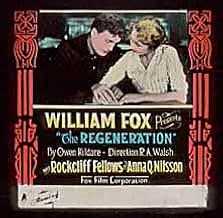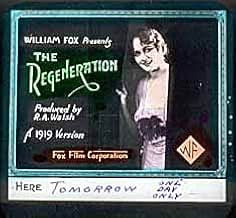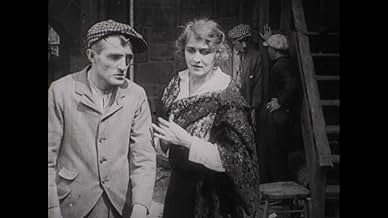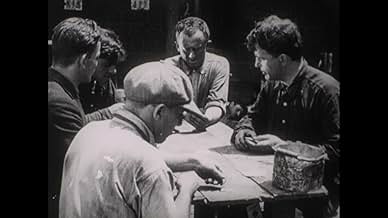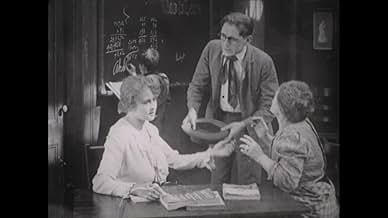IMDb RATING
6.8/10
1.5K
YOUR RATING
A boy surrounded by violence grows up to become an infamous gangster.A boy surrounded by violence grows up to become an infamous gangster.A boy surrounded by violence grows up to become an infamous gangster.
- Awards
- 1 win total
James A. Marcus
- Jim Conway
- (as James Marcus)
Harry McCoy
- Owen - Age 17
- (as H. McCoy)
Peggy Barn
- Woman
- (uncredited)
William Dyer
- Drunk Friend of Jim Conway
- (uncredited)
Featured reviews
Raoul Walsh had been an actor and an understudy assistant director under D. W. Griffith when Fox Films hired him to direct his first feature film, September 1915's "Regeneration." Many cite Walsh's full-length directorial debut as cinema's first gangster feature film.
Walsh had run away from home at 15 and worked a series of laborious, dangerous jobs, including a cow hand and a seafarer. His hands at that time were so calloused he refused to shake hands. Because of his horse-riding skills, D. W. Griffith hired him as an actor, with one of his first roles as a young version of Mexican revolutionist Pancho Villa.
Walsh showed enough of a curiosity of filmmaking that Griffith took him on as an assistant director, most notably helping him out in "The Birth of a Nation." In the 1915 film, Walsh also plays John Wilkes Booth, who kills Abraham Lincoln. Newly formed Fox Films Corporation heard and saw so many good things from Walsh that William Fox hired him to do one of his studio's first feature films.
"Regeneration," adapted from a 1908 play based on Owen Kildare's autobiography, was a redemption tale of a boy who grew up to become a criminal, but eventually realizing the wrongs he had committed through the guiding influence of a female social worker. Walsh decided to film in New York City's poor Lower East Side using actual criminals and prostitutes to heighten his movie's authenticity.
Elements of Griffith, who Walsh labeled as his teacher, is clearly visible in "Regeneration:" the masking of the lens, the parallel editing and camera positioning, numerous close ups and implementing newly devised cinematic techniques such as a handful of dolly movements. Certain scenes Walsh filmed contained chiaroscuro lighting, anticipating Germanic Expressionism film aesthetics by a few years.
Walsh would become one of Hollywood's auteurs noted for his hard-hitting, macho crime movies such as 1939's "The Roaring Twenties," 1941 "High Sierra," and 1949's "White Heat." He would direct until his final film in 1964, and have a script of his produced as a movie in 1970.
Walsh had run away from home at 15 and worked a series of laborious, dangerous jobs, including a cow hand and a seafarer. His hands at that time were so calloused he refused to shake hands. Because of his horse-riding skills, D. W. Griffith hired him as an actor, with one of his first roles as a young version of Mexican revolutionist Pancho Villa.
Walsh showed enough of a curiosity of filmmaking that Griffith took him on as an assistant director, most notably helping him out in "The Birth of a Nation." In the 1915 film, Walsh also plays John Wilkes Booth, who kills Abraham Lincoln. Newly formed Fox Films Corporation heard and saw so many good things from Walsh that William Fox hired him to do one of his studio's first feature films.
"Regeneration," adapted from a 1908 play based on Owen Kildare's autobiography, was a redemption tale of a boy who grew up to become a criminal, but eventually realizing the wrongs he had committed through the guiding influence of a female social worker. Walsh decided to film in New York City's poor Lower East Side using actual criminals and prostitutes to heighten his movie's authenticity.
Elements of Griffith, who Walsh labeled as his teacher, is clearly visible in "Regeneration:" the masking of the lens, the parallel editing and camera positioning, numerous close ups and implementing newly devised cinematic techniques such as a handful of dolly movements. Certain scenes Walsh filmed contained chiaroscuro lighting, anticipating Germanic Expressionism film aesthetics by a few years.
Walsh would become one of Hollywood's auteurs noted for his hard-hitting, macho crime movies such as 1939's "The Roaring Twenties," 1941 "High Sierra," and 1949's "White Heat." He would direct until his final film in 1964, and have a script of his produced as a movie in 1970.
I became obsessed with this movie two years ago after checking it out of our great NYC library. I rave about it to my friends. To think that this full-length feature was made in l915 is astounding. Maybe it's because of its amazing star, Rockliffe Fellowes, who looks so much like Marlon Brando you'll be double-takes. That he never became a legendary star is a real tragedy but when you think of it, almost none of the film actors from that era survived into the 20s except for Mary Pickford and a few comedians. Rockcliffe is so natural, as is his co-star, the beautiful Anna Q. Nillsen, you have to remind yourself that they were acting. This movie should be studied in film courses to show today's younger movie buffs what dynamic work was being done back int he "dinosaur" age of films. And maybe, like myself, they'll never forget the fantastic Rockliffe Fellowes. This guy "coulda been a contendah!"
In cinema, 1915 is best known as the year of DW Griffith's epic Birth of a Nation. While I won't play down the talents and achievements of Griffith, his debut feature was merely a culmination of his prior achievements, a milestone in cinema culture but adding nothing to cinematic language. Regeneration however, a largely overlooked film (although it has its champions), was perhaps truly the most important picture of that year.
Raoul Walsh, previously an assistant to Griffith, and already having a handful of short features to his name, made his full-length debut with this romantic gangster fable. The picture opens fairly conventionally for the time, Walsh displaying an incredibly firm grasp of film form for such a young director. The opening shot establishes the mood - the recently bereaved protagonist sitting alone in a bare room, a curtain billowing forlornly behind him, after which we cut away to the hearse bearing his mother in the street outside. However, we then see the lad go to the window and look down. In the very next shot, the camera is looking down at the hearse, exactly as he would see it. Bam! The point-of-view shot is born.
The point-of-view shot is not merely a convenient alternative angle for storytelling. It places the audience into the position of the character. It's something unique to cinema you can't recreate that in the theatre. The only real equivalent is in novels, when the narrative is told from a character's perspective. Walsh here gives cinema that ability, and moves the audience from the position of spectator to that of participant. It's particularly apt too for Regeneration, as it was adapted from an autobiography. Walsh remains consistent to the story's roots by primarily showing the points of view of the protagonist, Owen.
Another great thing about Regeneration is its use of dolly shots that is, moving the camera in or out, towards or away from the action. This wasn't an innovation as such, the dolly having been invented by Giovanni Pastrone for his 1914 epic Cabiria, but the dolly shots in that picture are largely uninspired, at best creating smooth transitions between different length shots. Walsh however really explores the possibilities of the technique. First he uses it to home in on the young Owen in the scene where his adoptive parents argue over the dinner table. Again this is a move which draws us into the character's world, as if we are being pulled forward and forced to look. Much later, in the scene where Anna Q. Nilsson bursts into the gangster's den, the camera itself rushes forward, reaching the centre of the shot at the same pace she does. In effect, the camera movement mimics hers and gives the audience a little taste of her sense of urgency.
Needless to say, there is a lot more to Regeneration than these pioneering camera techniques. Walsh's handling of the dynamic moments is particularly adept, with a climactic ride-to-the-rescue worthy of Griffith, and some particularly realistic fight scenes. But he was just as capable of great tenderness as he was of great action, and the picture is shot through with the sense of melancholy romanticism that is typical of Walsh. And let's not forget the fine naturalistic acting on display, although stars Rockliffe Fellowes and Anna Q. Nilsson would soon fade into obscurity.
By way of a disclaimer, I should point out that Regeneration may not literally be the first motion picture to use point-of-view shots. There was, after all, a wealth of experimentation in the early days of cinema, and many films are obscure or lost. It is shortly after this though that the technique seems to enter mainstream usage. For example, Cecil B. DeMille's The Cheat, made several months after Regeneration, features point-of-view shots, whereas DeMille's Carmen, made about the same time as Regeneration, does not. Tag Gallagher, in his superb essay on Walsh for Senses of Cinema, makes similar claims. Whatever the case, Walsh certainly excelled in a new kind of cinema, one which placed the audience inside the story, and this principle would shape much of Walsh's work throughout his fifty-year career.
Raoul Walsh, previously an assistant to Griffith, and already having a handful of short features to his name, made his full-length debut with this romantic gangster fable. The picture opens fairly conventionally for the time, Walsh displaying an incredibly firm grasp of film form for such a young director. The opening shot establishes the mood - the recently bereaved protagonist sitting alone in a bare room, a curtain billowing forlornly behind him, after which we cut away to the hearse bearing his mother in the street outside. However, we then see the lad go to the window and look down. In the very next shot, the camera is looking down at the hearse, exactly as he would see it. Bam! The point-of-view shot is born.
The point-of-view shot is not merely a convenient alternative angle for storytelling. It places the audience into the position of the character. It's something unique to cinema you can't recreate that in the theatre. The only real equivalent is in novels, when the narrative is told from a character's perspective. Walsh here gives cinema that ability, and moves the audience from the position of spectator to that of participant. It's particularly apt too for Regeneration, as it was adapted from an autobiography. Walsh remains consistent to the story's roots by primarily showing the points of view of the protagonist, Owen.
Another great thing about Regeneration is its use of dolly shots that is, moving the camera in or out, towards or away from the action. This wasn't an innovation as such, the dolly having been invented by Giovanni Pastrone for his 1914 epic Cabiria, but the dolly shots in that picture are largely uninspired, at best creating smooth transitions between different length shots. Walsh however really explores the possibilities of the technique. First he uses it to home in on the young Owen in the scene where his adoptive parents argue over the dinner table. Again this is a move which draws us into the character's world, as if we are being pulled forward and forced to look. Much later, in the scene where Anna Q. Nilsson bursts into the gangster's den, the camera itself rushes forward, reaching the centre of the shot at the same pace she does. In effect, the camera movement mimics hers and gives the audience a little taste of her sense of urgency.
Needless to say, there is a lot more to Regeneration than these pioneering camera techniques. Walsh's handling of the dynamic moments is particularly adept, with a climactic ride-to-the-rescue worthy of Griffith, and some particularly realistic fight scenes. But he was just as capable of great tenderness as he was of great action, and the picture is shot through with the sense of melancholy romanticism that is typical of Walsh. And let's not forget the fine naturalistic acting on display, although stars Rockliffe Fellowes and Anna Q. Nilsson would soon fade into obscurity.
By way of a disclaimer, I should point out that Regeneration may not literally be the first motion picture to use point-of-view shots. There was, after all, a wealth of experimentation in the early days of cinema, and many films are obscure or lost. It is shortly after this though that the technique seems to enter mainstream usage. For example, Cecil B. DeMille's The Cheat, made several months after Regeneration, features point-of-view shots, whereas DeMille's Carmen, made about the same time as Regeneration, does not. Tag Gallagher, in his superb essay on Walsh for Senses of Cinema, makes similar claims. Whatever the case, Walsh certainly excelled in a new kind of cinema, one which placed the audience inside the story, and this principle would shape much of Walsh's work throughout his fifty-year career.
People who think that all silents are sticky with Victorian melodrama will be surprised by the sustained pace, the bracing realism, and the soft-pedaling of the sentimental elements of this startlingly fresh film. The 28-year old Raoul Walsh had already written and produced a dozen films when he directed this. Although the narrative rambles a bit, Walsh's dynamic use of film grammar - closeups, dollies in and out, cross-cutting between scenes, sharp editing - makes REGENERATION look more modern than many silent films made ten years later. Walsh shows his creativity when he uses the circling movements of dancers to foreshadow public panic in an impressively staged sequence of a fire [although it has little plot function]. Titles are used sparingly throughout, and even they are terse and direct. The performances are also surprisingly natural, from square-jawed Rockcliffe Fellowes [who looks something like Robert Stack] to Anna Q. Nilsson, who gives a delicate, sympathetic performance as the good girl/settlement worker. Within the outline of a traditional melodrama, Walsh forthrightly portrays the underside of contemporary society, keeps the sentiment light, and provides an ending that is not without surprises either.
Raoul Walsh had just come off _The Birth of a Nation_ both as one of Griffith's assistant directors and as an actor (most prominently as John Wilkes Booth), when he made this film. In his autobiography, Walsh credits Griffith with "teaching" him not only about much of the art of fiction filmmaking, but also about production management technics that aided him in taking full advantage of many of New York City's most pictorial exterior locations.
The locations play an important role in adding to the naturalism of an otherwise highly melodramatic plot with the high society young woman turned heroine social worker (much overplayed by a major star of the 1910s, Anna Q Nilsson) and the regeneration of the one-time Lower Manhatan gang leader.
The wonder of this film is the performance of the male "star", Rockliffe Fellowes, who played in over a dozen nearly unremembered films until he died in 1950. His performance is so subtly varied and electrically alive that one is reminded of Brando in his early 1950s films. An interesting sidenote about his performance: The movieola film editing machine -- that magnified the small 35mm frame to about 4 inches by 6 inches as it ran the film stock through the viewer at the proper projection speed -- was not invented until much later. In 1915, editors had to hold the footage up to the light to see each frame and/or use a magnifying glass; but they could not also run the film at speed at the same time. Hence, many of the subtlest nuances that cross the hero's face could not be clearly seen and judged in editing: _Regeneration's_ editor often cuts away before the movement has settled, or cuts into a close or medium shot of the hero after the nuance has already begun.
Watching the film on a large screen today, one is aware how powerful present-day editing technics are at capturing all such movements in the hands of a skilled editor. In _Regeneration_ there is a distinct feeling of rough editing at the moments we leave or cut to the hero at the "wrong" instant. By the way, the original title was NOT _The Regeneration_, but _Regeneration_ alone. From which we can surmise that Walsh was looking to create a work with universal meaning.
The locations play an important role in adding to the naturalism of an otherwise highly melodramatic plot with the high society young woman turned heroine social worker (much overplayed by a major star of the 1910s, Anna Q Nilsson) and the regeneration of the one-time Lower Manhatan gang leader.
The wonder of this film is the performance of the male "star", Rockliffe Fellowes, who played in over a dozen nearly unremembered films until he died in 1950. His performance is so subtly varied and electrically alive that one is reminded of Brando in his early 1950s films. An interesting sidenote about his performance: The movieola film editing machine -- that magnified the small 35mm frame to about 4 inches by 6 inches as it ran the film stock through the viewer at the proper projection speed -- was not invented until much later. In 1915, editors had to hold the footage up to the light to see each frame and/or use a magnifying glass; but they could not also run the film at speed at the same time. Hence, many of the subtlest nuances that cross the hero's face could not be clearly seen and judged in editing: _Regeneration's_ editor often cuts away before the movement has settled, or cuts into a close or medium shot of the hero after the nuance has already begun.
Watching the film on a large screen today, one is aware how powerful present-day editing technics are at capturing all such movements in the hands of a skilled editor. In _Regeneration_ there is a distinct feeling of rough editing at the moments we leave or cut to the hero at the "wrong" instant. By the way, the original title was NOT _The Regeneration_, but _Regeneration_ alone. From which we can surmise that Walsh was looking to create a work with universal meaning.
Did you know
- TriviaMost of the extras in this film were real locals from the Bowery area, as well as from Hell's Kitchen, and had never appeared before in films. Most of the gangster characters were actual gangsters in real life.
- Quotes
District Attorney Ames: Very fine and loyal, my boy, but you can't save your friend, and you have lost whatever chance you had - with her.
- Crazy creditsThere is no cast list during the opening credits or at the end. Actors, however, are credited by intertitles as they appear within the movie, and that is used for the IMDb cast ordering. Actors never mentioned are marked uncredited.
- Alternate versionsKino International released a version which runs 72 minutes and contains an uncredited piano score.
Details
- Release date
- Country of origin
- Language
- Also known as
- Régénération
- Filming locations
- Hudson River, Nyack, New York, USA(burning of the excursion barge)
- Production company
- See more company credits at IMDbPro
- Runtime1 hour 12 minutes
- Color
- Sound mix
- Aspect ratio
- 1.33 : 1
Contribute to this page
Suggest an edit or add missing content


